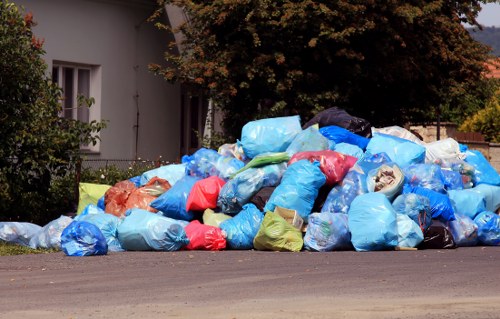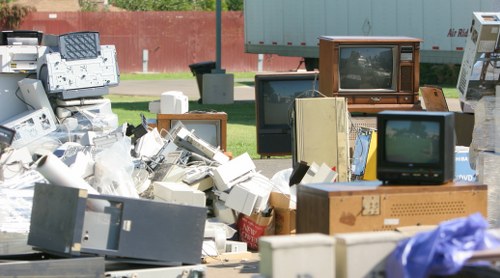Office Clearances in House Clearances: A Comprehensive Guide

When it comes to house clearances, most people focus on personal belongings, furniture, and household items. However, incorporating office clearances into this process can significantly enhance efficiency and organization. Office clearances involve the systematic removal and disposal of office equipment, documents, and furniture, ensuring a smooth transition whether you're downsizing, relocating, or clearing out a deceased person's residence.
Integrating office clearances within house clearances not only streamlines the process but also ensures that all items, both personal and professional, are handled appropriately. This comprehensive approach reduces the stress and complexity often associated with clearing out an entire household, making the experience more manageable and less overwhelming.
In this article, we will explore the nuances of office clearances in house clearances, highlighting their importance, benefits, and the best practices to follow. Whether you're planning a move, downsizing, or dealing with an estate, understanding how to effectively incorporate office clearances can save you time, money, and effort.

What are Office Clearances?
Office clearances refer to the organized process of removing office-related items from a space. This includes furniture, electronic equipment, documents, and other professional materials. The goal is to efficiently declutter and dispose of these items in a manner that is both responsible and compliant with any applicable regulations.
In the context of house clearances, office clearances become relevant in various scenarios, such as when a home office is being downsized, when a business is relocating and its assets are stored at a residential property, or when clearing out the belongings of someone who maintained a home office.
Effective office clearances ensure that valuable or sensitive items are handled with care. This includes proper disposal of confidential documents, recycling outdated electronics, and responsibly donating or selling usable office furniture and equipment. By addressing office items alongside household belongings, the clearance process becomes more comprehensive and integrated.

Definition and Importance
At its core, office clearances involve the systematic removal of office-related possessions from a designated space. This can range from basic furniture and equipment to more complex items like filing systems, computers, and specialized office machinery.
The importance of office clearances within house clearances cannot be overstated. Offices often contain items that are not only valuable but also sensitive in nature. Handling these items appropriately is crucial to maintaining privacy, ensuring data protection, and complying with legal obligations.
Moreover, integrating office clearances into the broader house clearance process leads to a more organized and efficient removal experience. It allows for better planning, coordination, and execution, ensuring that both personal and professional items are addressed in a cohesive manner.

Differences Between Office and House Clearances
While both office and house clearances share the common goal of decluttering and removing items, they differ significantly in terms of scope, scale, and the nature of items involved.
Scope and Scale: House clearances typically focus on personal belongings, ranging from furniture and clothing to household appliances and memorabilia. In contrast, office clearances deal with a broader range of items, including office furniture, electronic equipment, filing systems, and potentially large quantities of paper documents.
Types of Items Handled: Household items are often more varied and less standardized, whereas office items tend to be more uniform and may require specialized handling. For example, dismantling and recycling office electronics like computers and printers require specific procedures to ensure data security and environmental compliance.

Scope and Scale
The scope of office clearances is generally more extensive due to the diversity and number of items involved. Offices may contain multiple types of equipment, from basic desks and chairs to specialized machinery and technology. The scale can also vary depending on the size of the office, the duration it has been in use, and the nature of the business.
In a house clearance, the scale may be limited to what a single household can accumulate over time, making it a more manageable task. Office clearances, on the other hand, often require professional handling due to the larger volume and complexity of items, especially when dealing with businesses that have been operational for many years.
Recognizing the differences in scope and scale is essential for effective planning and resource allocation. It ensures that the appropriate manpower, tools, and strategies are employed to address the unique challenges posed by office clearances within house clearances.
Types of Items Handled
Office clearances typically involve a variety of items that are distinct from those found in a typical household clearance. These include:
- Office Furniture: Desks, chairs, filing cabinets, bookshelves, and conference tables.
- Electronic Equipment: Computers, printers, fax machines, servers, and telecommunication devices.
- Documents and Files: Piles of paperwork, sensitive documents, and extensive filing systems.
- Specialized Office Supplies: Items like shredders, copiers, and other office machinery.
Each of these items requires specific handling methods to ensure they are removed efficiently and responsibly. For instance, electronic equipment often needs to be recycled or disposed of in accordance with environmental regulations, while sensitive documents must be securely destroyed to protect privacy.

Benefits of Including Office Clearances in House Clearances
Integrating office clearances into the overall house clearance process offers numerous advantages. These benefits range from increased efficiency and cost savings to enhanced organization and compliance with legal requirements.
Streamlined Process: Combining office and house clearances allows for a more coordinated approach. Scheduling one comprehensive clearance reduces the need for multiple appointments and ensures that all items are addressed in a unified manner.
Cost-Effective: Hiring professionals to handle both office and house clearances simultaneously can lead to cost savings. Bundling services often results in discounted rates, and the overall process becomes more efficient, reducing the time and labor required.

Streamlined Process
When office clearances are managed alongside house clearances, the entire removal process becomes more seamless. Coordinating the movement of items from different areas of the home ensures that everything is systematically addressed without the need for repeated movements or multiple service calls.
This integrated approach minimizes disruptions and allows for better time management. It ensures that all possessions, whether personal or professional, are cleared out in a logical sequence, reducing the chances of items being overlooked or mishandled.
Additionally, a streamlined process enhances communication between all parties involved, including the homeowners, clearance professionals, and any third-party services. Clear communication ensures that expectations are met and that the clearance progresses smoothly from start to finish.

Cost-Effective
Managing office and house clearances together can significantly reduce costs associated with the removal process. Instead of paying for separate services, bundling allows homeowners to take advantage of package deals and discounted rates offered by clearance companies.
Furthermore, a combined clearance reduces the overall time required to complete the task, resulting in lower labor costs. The efficiency gained from addressing all items at once means fewer hours billed by professionals, leading to substantial savings.
Moreover, handling clearances together minimizes the need for additional resources such as transportation, storage, and disposal fees. By consolidating these aspects, homeowners can achieve a more economical clearance experience without compromising on quality or thoroughness.

How to Plan for Office Clearances in House Clearances
Proper planning is crucial for successfully integrating office clearances into house clearances. It ensures that the process is organized, efficient, and minimizes potential challenges. Here are the key steps to consider when planning for a combined clearance:
Assessment and Inventory: Begin by conducting a thorough assessment of both personal and office items. Create an inventory list categorizing items that need to be cleared, retained, donated, or disposed of. This inventory will serve as a roadmap for the clearance process, helping to prioritize tasks and allocate resources effectively.
Hiring Professional Services: Engaging a reputable clearance company that offers both house and office clearance services is essential. Professional cleaners have the expertise and equipment to handle a diverse range of items, ensuring that both personal and professional belongings are cleared efficiently and responsibly.

Assessment and Inventory
Creating a detailed inventory is the foundation of a successful clearance. Start by listing all items in each area, distinguishing between personal and office possessions. For office items, pay special attention to any sensitive documents, electronic equipment, and specialized furniture that may require specific handling.
Evaluating each item's condition and utility is also important. Decide which items to keep, sell, donate, or dispose of based on factors like usefulness, sentimental value, and potential resale value. This evaluation helps in minimizing clutter and ensuring that only necessary items are retained or removed.
Additionally, identifying hazardous materials or items that require special disposal methods, such as electronics or chemicals, allows for proper planning and compliance with environmental regulations.

Hiring Professional Services
Selecting the right clearance service is pivotal for a smooth clearance process. Look for companies that specialize in both house and office clearances, as they will have the necessary experience and resources to handle a wide range of items.
When evaluating potential firms, consider factors such as their reputation, range of services offered, pricing structure, and customer reviews. A reliable company should provide transparent pricing, detailed service descriptions, and demonstrate a commitment to quality and customer satisfaction.
Additionally, ensure that the clearance company adheres to all relevant regulations, particularly concerning the disposal of sensitive documents and electronic waste. Certifications or memberships in professional associations can also be indicators of a company's credibility and adherence to industry standards.

Steps Involved in the Clearance Process
Understanding the steps involved in office clearances within house clearances is essential for ensuring an organized and efficient removal process. Here's a breakdown of the typical steps involved:
- Sorting and Categorizing: Begin by sorting items into categories such as keep, donate, sell, or dispose. This step helps in organizing the clearance and deciding the fate of each item.
- Removal and Disposal: Once items are categorized, proceed to remove them from the property. This may involve packing, transporting, and disposing of items according to their designated categories.
- Recycling and Donating: Ensure that recyclable items are processed appropriately and that donations are made to suitable organizations. This step promotes environmental responsibility and community support.
Each of these steps requires careful planning and execution to ensure that the clearance is completed efficiently and responsibly.

Sorting and Categorizing
The initial step in the clearance process involves meticulously sorting through all items. Categorizing items helps in determining the best course of action for each, whether it's keeping, donating, selling, or disposing of them.
For office items, this step is particularly important due to the variety and potential sensitivity of the possessions. Separate confidential documents from general office supplies, and identify equipment that can be donated or recycled.
A clear categorization process ensures that nothing is overlooked and that each item is handled in the most appropriate manner. It also facilitates a smoother removal process, as items are already organized and assigned their respective categories.

Removal and Disposal
Once items are sorted, the next step is the physical removal from the property. This involves packing items carefully to prevent damage, especially fragile office equipment and valuable documents.
Disposal should be carried out responsibly, adhering to local regulations and environmental guidelines. Electronic equipment should be recycled through certified programs, while hazardous materials require specialized disposal methods.
For items designated for disposal, ensure that they are removed promptly to prevent clutter from accumulating again. Hiring professionals can greatly facilitate this step, as they have the expertise and resources to handle various types of items efficiently.
Recycling and Donating
Recycling and donating are crucial components of the clearance process, promoting sustainability and community support. Recycling office electronics helps reduce environmental impact, while donating gently used office furniture and supplies can benefit individuals or organizations in need.
When recycling, ensure that items are processed through reputable facilities that adhere to environmental standards. Proper recycling of electronics prevents harmful substances from entering the ecosystem and conserves valuable materials.
Donating items not only helps others but can also provide tax benefits. By identifying organizations that accept office donations, you contribute to a positive cause while decluttering your space responsibly.

Common Challenges and Solutions
Clearancing both office and house items can present several challenges. Understanding these potential obstacles and having strategies to overcome them is essential for a successful clearance process.
Handling Sensitive Documents: Office clearances often involve dealing with confidential or sensitive documents that require secure destruction to protect personal and business information.
Managing Bulky Items: Both house and office clearances can involve large and heavy items such as furniture, file cabinets, and electronic equipment, making their removal physically demanding and logistically complex.

Handling Sensitive Documents
One of the primary challenges in office clearances is managing sensitive documents. These documents may contain confidential information that must be securely destroyed to prevent unauthorized access and protect privacy.
Professional clearance services often offer shredding or secure document destruction as part of their services. This ensures that all sensitive information is irretrievably destroyed, complying with data protection regulations and maintaining confidentiality.
Alternatively, homeowners can use certified shredding services or invest in a high-quality shredder for on-site destruction. Proper handling of sensitive documents is not only a legal obligation but also a critical aspect of maintaining trust and security.

Managing Bulky Items
Removing large and heavy items can be physically challenging and may require specialized equipment or transportation. Items like office desks, filing cabinets, and bulky furniture need careful planning to ensure their safe removal without causing damage to the property or the items themselves.
Hiring professional clearance services can alleviate this challenge, as they have the necessary tools, such as forklifts and trucks, to handle bulky items efficiently. Additionally, professionals are trained to disassemble and reassemble furniture when necessary, ensuring smooth removal and transportation.
For those opting to handle bulky items themselves, it's essential to have a clear plan. This includes measuring pathways to ensure items can be moved without obstruction, enlisting the help of friends or family, and using appropriate moving equipment to prevent injury and damage.

Legal Considerations in Office Clearances
Compliance with legal requirements is a critical aspect of office clearances within house clearances. Ensuring that all actions adhere to relevant laws and regulations protects homeowners from potential legal repercussions and fosters responsible clearance practices.
Data Protection: Handling sensitive information requires adherence to data protection laws. Improper disposal of personal or business data can lead to identity theft, financial loss, and legal penalties.
Compliance with Regulations: Different types of items, especially electronic equipment and hazardous materials, are subject to specific disposal regulations. Non-compliance can result in fines and environmental harm.

Data Protection
Data protection laws, such as the General Data Protection Regulation (GDPR) in Europe, mandate the secure handling and disposal of personal and sensitive information. During office clearances, this means ensuring that all documents containing personal data are destroyed securely.
Utilizing professional shredding services or secure destruction methods is essential to comply with these laws. Failure to do so can result in hefty fines and damage to one's reputation, especially for businesses that may be held accountable for data breaches.
Moreover, maintaining a clear data destruction policy as part of the clearance process ensures that all sensitive information is handled consistently and securely, mitigating the risk of accidental data exposure.

Compliance with Regulations
Beyond data protection, various regulations govern the disposal of specific types of items commonly found in offices. For example, electronic waste must be recycled through certified facilities to prevent environmental contamination, while certain chemicals or materials may require special handling and disposal procedures.
Understanding and adhering to these regulations is crucial to avoid legal penalties and ensure ethical clearance practices. Clearance services that are knowledgeable about local and national regulations can navigate these requirements effectively, ensuring that all items are disposed of appropriately.
Additionally, keeping records of clearance activities, such as documentation of where and how items were disposed of, provides proof of compliance and can be beneficial in case of audits or legal inquiries.

Conclusion
Integrating office clearances into house clearances offers a holistic approach to decluttering and organizing both personal and professional spaces. This comprehensive method not only enhances efficiency and cost-effectiveness but also ensures that all items are handled responsibly and in compliance with legal requirements.
By understanding the unique challenges and benefits of office clearances within house clearances, homeowners can plan and execute a smooth removal process. From thorough assessment and inventory to the careful disposal of sensitive documents and bulky items, each step plays a vital role in achieving a successful clearance.
Don't let the complexity of combined clearances overwhelm you. Contact us today to learn more about our specialized services that cater to both house and office clearances. Our professional team is ready to assist you in making your clearance process seamless and stress-free.